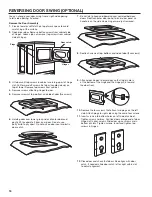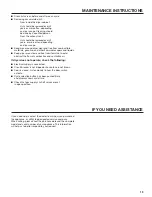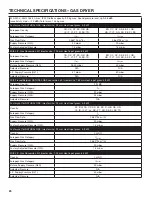
5
DRYER SAFETY
n
Do not install or store the dryer where it will be exposed
to the weather.
n
Do not tamper with controls.
n
Clean dryer lint screen before or after each load.
n
Do not use this dryer without the lint screen in place.
n
Do not repair or replace any part of the dryer or attempt
any servicing unless specifically recommended in
this Use and Care Guide or in published user-repair
instructions that you understand and have the skills
to carry out.
n
Do not use fabric softeners or products to eliminate static
unless recommended by the manufacturer of the fabric
softener or product.
n
Do not use heat to dry articles containing foam rubber
or similarly textured rubber-like materials.
n
The final part of a tumble dryer cycle occurs without
heat (cool-down cycle) to ensure that the articles are left
at a temperature that ensures that the items will not be
damaged.
n
WARNING:
Never stop a tumble dryer before the end
of the drying cycle unless all items are quickly removed
and spread out so that the heat is dissipated. (Avoids risk
of spontaneous combustion).
n
In case of electrical supply failure, remove the load
quickly and spread it out to avoid risk of spontaneous
combustion.
n
Keep area around the exhaust opening and adjacent
surrounding areas free from the accumulation of lint, dust,
and dirt.
n
The fresh air ventilation openings into the room and into
the dryer must not be blocked or sealed.
n
Emergency stop control: After installation, access to
mains plug or disconnection from mains supply via a
double-pole switch must be ensured at all times in order
to ensure immediate deactivation of the dryer in case of
emergency.
n
The interior of the dryer and dryer exhaust vent should be
cleaned periodically by qualified service personnel.
n
See “Electrical Requirements” section for earthing
instructions.
n
The dryer shall be disconnected from its power source
during service and when replacing parts. If the removal
of the plug is foreseen, it shall be clearly indicated that it
be possible for the operator to confirm the removal of the
plug from any point of access.
If this is not possible due to the construction of the
appliance or its installation, a disconnection with a
locking system in the isolated position shall be provided.
IMPORTANT SAFETY INSTRUCTIONS
WARNING:
To reduce the risk of fire, electric shock, or injury to persons when using the dryer, follow basic precautions,
including the following:
SAVE THESE INSTRUCTIONS
n
Read all instructions before using
the dryer.
n
This dryer is intended only for drying clothes and textiles
that have been washed in water. Do not use for any other
purpose.
n
WARNING:
If you smell gas, do not use the dryer or any
electrical equipment nearby. Warn other people to clear
the area. Contact the dryer owner immediately.
n
Do not place items exposed to cooking oils in your dryer.
Items contaminated with cooking oils may contribute to
a chemical reaction that could cause a load to catch fire.
To reduce the risk of fire due to contaminated loads, the
final part of a tumble dryer cycle occurs without heat
(cool down period). Avoid stopping a tumble dryer before
the end of the drying cycle unless all items are quickly
removed and spread out so that the heat is dissipated.
n
If it is unavoidable that fabrics that contain vegetable or
cooking oil or that have been contaminated by hair care
products be placed in a tumble dryer, they should first
be washed in hot water with extra detergent – this will
reduce, but not eliminate the hazard.
n
Do not dry articles that have been previously
cleaned in, washed in, soaked in, or spotted with petrol,
dry-cleaning solvents, other flammable, or explosive
substances as they give off vapors that could ignite
or explode.
n
Items that have been soiled with substances such
as acetone, alcohol, petrol, kerosene, spot removers,
turpentine, waxes, and wax removers should be washed
in hot water with extra detergent before being dried in
the dryer.
n
Do not dry unwashed items in the dryer.
n
Do not use this dryer if industrial chemicals have been
used for cleaning. The possible presence of residual
quantities of aggressive or decomposed chemicals in
the load may produce damage to the dryer and harmful
fumes.
n
Do not allow children to play on or in the dryer. Close
supervision of children is necessary when the dryer is
used near children.
n
This dryer is not intended for use by persons (including
children) with reduced physical, sensory, or mental
capabilities, or lack of experience or knowledge,
unless they have been given supervision or instruction
concerning use of the dryer by a person responsible
for their safety.
n
Before the dryer is removed from service or discarded,
remove the door to the dryer compartment.
n
Do not reach into the dryer if the drum is moving.
n
Opening the dryer door will stop the function of the dryer.
n
When loading or re-loading the dryer, avoid touching hot
metal parts of the drum (burn risk).
n
If drum rotation is blocked due to trapped textiles,
disconnect the dryer from the electrical supply before
gently removing the blockage.
n
If the dryer is not heating, or appears to be defective or
damaged, do not use it. Contact the owner.
4
IMPORTANT SAFETY INSTRUCTIONS
precautions, including the following:
WARNING:
Read all instructions before using the dryer.
Keep a minimum clearance of 100 mm (4 in.) between the
rear of the dryer and any wall.
The operation of this appliance may affect the operation of
other types of appliances which take their air supply for safe
combustion from the same room. There has to be adequate
ventilation to replace exhausted air and thus avoid the
back-flow of gases into the room from appliances burning
other fuels, including open fires, when operating the tumble
dryer. If in doubt, consult the appliance manufacturers.
Do not obstruct the air supply to the dryer (see Installation
Instructions for minimum clearances).
Do not place items exposed to cooking oils in your dryer.
Oil-affected items can ignite spontaneously, especially when
exposed to heat sources such as in a tumble dryer. The
items become warm causing an oxidation reaction in the oil.
Oxidation creates heat. If the heat cannot escape, the items
can become hot enough to catch fire. Piling, stacking or
storing oil-affected items can prevent heat from escaping
and so create a fire hazard.
If it is unavoidable to dry in the dryer items that have been
soiled with substances such as cooking oil, acetone, alcohol,
petrol, kerosene, spot removers, turpentine, waxes and wax
removers, or that have been contaminated by hair care
products, should be washed in hot water with an extra
amount of detergent before being dried in the dryer. These
items may give off vapours that could ignite or explode. Such
washing will reduce, but not eliminate, the hazard.
This appliance is not intended for use by persons (including
children) with reduced physical, sensory or mental
capabilities, or lack of experience and knowledge, unless
they have been given supervision or instructions concerning
use of the appliance by persons responsible for their safety.
Children should be supervised to ensure that they do not
play with the appliance.
The dryer should not be used if industrial chemicals have
been used for cleaning.
Before the dryer is removed from service or discarded,
remove the doors to the drying compartment.
Do not reach into the dryer if the drum is moving. A door
switch is fitted for your safety.
Do not install or store the dryer where it will be exposed
to the weather.
Do not tamper with controls.
Do not continue to use this appliance if it appears to be
faulty.
Do not repair or replace any part of the dryer or attempt
any maintenance unless specifically recommended in this
Use and Care Guide. Repairs and servicing should only
be carried out by competent service personnel.
Do not use fabric softeners or products to eliminate static
unless recommended by the manufacturer of the fabric
softener or product. Follow their instructions.
Clean dryer lint screen before or after each load. Do not
operate dryer without lint screen in place.
Keep area around the exhaust and inlet openings and
adjacent surrounding areas free from the accumulation of
lint, dust, and dirt.
The interior of the dryer and exhaust vent should be
cleaned periodically by qualified service personnel.
See Installation Instructions for earthing instructions.
Do not dry unwashed items in this dryer.
Items such as foam rubber (latex foam), shower caps,
waterproof textiles, rubber backed articles and clothes or
pillows fitted with foam rubber pads must only be dried
on a clothesline.
SAVE THESE INSTRUCTIONS
WARNING:
Never stop a tumble dryer cycle before the
end of the drying cycle unless all items are quickly removed
and spread out so that the heat is dissipated.
To reduce the risk of fire, electric shock, or injury to persons when using the dryer, follow basic
The final part of a tumble dryer cycle occurs without heat
(cool down cycle) to ensure that the items are left at a
temperature that ensures the items will not be damaged.
If the supply cord is damaged, it must be replaced by the
manufacturer or its service agent or a similarly qualified
person in order to avoid a hazard.






































